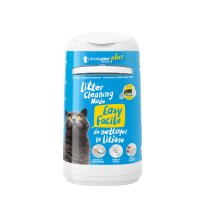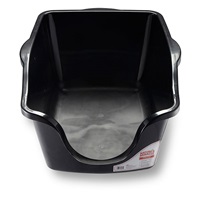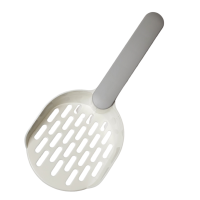Select a topic to learn more
If cats litter trained us, what would they expect?
Learn their litter box preferences
 Cats are notoriously clean animals and they take litter box business quite seriously. With so many litter products fighting for attention in the marketplace, cat owners can easily overspend on items cats don’t even like but merely tolerate. Shopping for litter is almost as complicated as shopping for their food, isn’t it? Keep this in mind though: cats don’t care how much you spend on their litter box or substrate. They want the box they want, the substrate they want, and they want it scooped every day.
Cats are notoriously clean animals and they take litter box business quite seriously. With so many litter products fighting for attention in the marketplace, cat owners can easily overspend on items cats don’t even like but merely tolerate. Shopping for litter is almost as complicated as shopping for their food, isn’t it? Keep this in mind though: cats don’t care how much you spend on their litter box or substrate. They want the box they want, the substrate they want, and they want it scooped every day.
Types of litter boxes
Let’s get into the box itself, first. There are small ones, large ones, covered ones, disposable ones, self-cleaning ones and even ones that look like living room furniture. The most popular with the kitties is a large, uncovered box. It needs to be large enough for your cat to stand on all four legs and turn around and a little extra digging room would be appreciated. Rule of thumb is that the box should be 1.5 times as long as your cat when he’s standing on all fours.
Being a species that is both predator and prey, cats will feel more comfortable if the box is uncovered so they can be aware of their surroundings and hop out at a moment’s notice. It can be stressful for some cats to use covered boxes, especially if they feel “trapped” inside it. That being said, some do like the added privacy of the cover and we understand that some dogs have a gross sense of humour and like to rummage through your kitty’s good work. If this is the case, a cover is fine so long as it’s easy to get in and out of, the litter substrate isn’t dusty, and you clean it more than once a day.
Kitty litter substrates
On to substrates. It can get even more complicated here if we let it. There is clumping and non-clumping clay, scented, unscented or “deodorized,” corn, pine, recycled newspaper, crystals…even colour changing crystals and “pretty” ones, too! This is where you and your cat can meet in the middle when making a choice. You may choose one over the other based on allergies, your budget or for ethical reasons. For example, clumping clay litter is budget-friendly and cats tend to like it, but it’s also dusty and non-biodegradable. Corn is a biodegradable and sustainable option but it costs more than clay and can attract insects. Crystals, the most expensive option is perhaps the most absorbent and is dust-free but many cats don’t like the feel of it under their toe beans and well…it’s pretty expensive. It’s hard to say which is best for you and your cat, so it’s worth trying a couple options that you’re comfortable with in separate boxes and see which one your cat uses more.
Scented litter STINKS
As an extension to the information on substrates, one thing is tried, tested and true – cats hate fragrances and deodorizers  added to and around their litter. The idea of scented litter was made purely for human satisfaction. Your cat may be using it now, but they’re likely just tolerating it. If you ever catch your kitty doing that side glare thing at you…this is why.
added to and around their litter. The idea of scented litter was made purely for human satisfaction. Your cat may be using it now, but they’re likely just tolerating it. If you ever catch your kitty doing that side glare thing at you…this is why.
Cats are very sensitive to smell and are easily put off by the scent of their own urine and feces when left in the box, as well as by smells that are pleasing to humans.” The research has been done and the verdict is cats prefer unscented litter. If the human cleans the box daily, the odour shouldn’t be a problem anyway! Choose the right substrate and clean the box daily for ultimate kitty and human satisfaction. It is also helpful (and is wise) to do a full box cleanout once every month. Dump everything out and clean the box with mild dish soap and warm water. Avoid using peroxide and other harsh chemicals because, as mentioned already, cats are sensitive to smell and may be put off by it.
 One litter box per cat + one
One litter box per cat + one
It’s the golden rule. Some cats like to separate #1s and #2s and they all need a backup when the nearest box is occupied or the area isn’t quiet and private enough when nature calls. Extra litter boxes are especially important in multi-pet homes, if there are young children in the home or if the daily routine can be unpredictable. It can be stressful for a cat when he feels threatened by using his litter box so knowing he has another option in another spot in the home will help him feel more confident about “enjoying the go.”
Where to put litter boxes
With the perfect box and the perfect substrate, if the location isn’t right, it’s all for nothing. As we know, cats are complex and sophisticated creatures! Put the box in the wrong spot, find a poop on your pillow when you go to bed…isn’t that how the saying goes? So what are the RIGHT spots? The requirements are long but easy enough to accommodate. Litter box locations must be quiet, private, predictable, separate parts of the home, easy to access, and easy to escape from.




